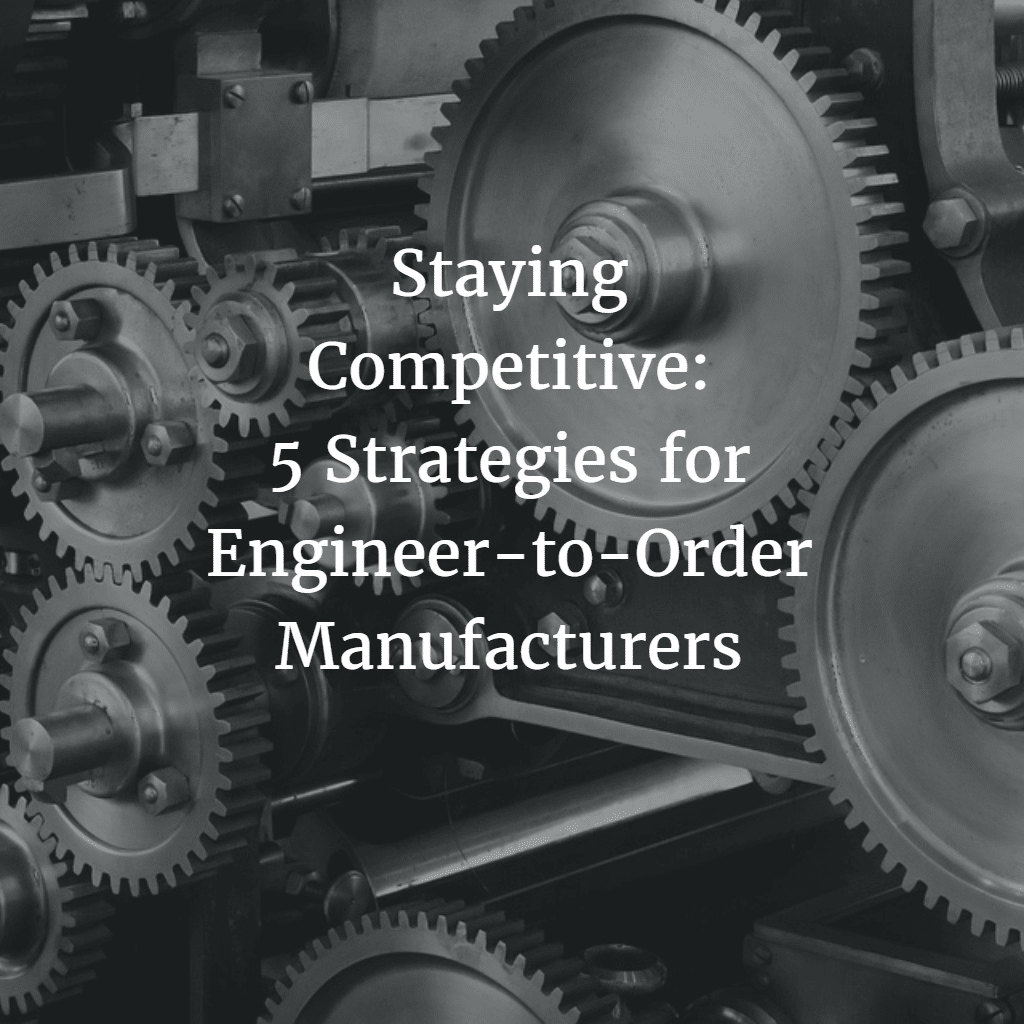If you run an engineering to order company, then you know how important it is to maintain standards and meet client expectations consistently. At the same time, you have to take on as large a workload as possible to maintain throughput and revenue. It can be hard to maintain a competitive edge while balancing quality and quantity. In this post, we will go over 5 key strategies that can help you remain focused and organized. Each one involves changing a specific characteristic of your workflow in a way that improves one or more outcomes. You can use at least one of them to meet your goals more efficiently and improve your bottom line.
Adopt A Project Management Mind-set
It is easy to simply treat each project as it comes and work through its specific challenges one at a time. That can help you for a while, but in the long run it is best to develop a comprehensive framework for managing all projects. Building a project manager’s approach to your workflow will improve your consistency, help you better manage resources among multiple projects, and increase the speed at which you successfully conclude projects.
The key is developing a generalized complex process that you can apply to any and all projects. You should be able to start with the customer’s needs and arrive at final delivery. Building that process means you can ensure you will maintain your standards despite variations from project to project. Your business can survive and even succeed simply by working on each project as it comes up, but to build a solid foundation for sustained and consistent quality you must formalize your strategic project management.
A good starting point is to choose a series of steps that can apply to every project to guide how you devote your attention, time, and resources to each problem and challenge along the way. For example, consider this sequence. First start with a pre-planning phase where you assess a proposal to make sure that you can do it on time and make a sufficient margin within the given specifications. Next, write a detailed plan and use that to pitch an estimate to the customer, taking into account your best guesses about the time it will take and its costs. Third, execute the plan by assembling the required skillsets and materials and completing the build to spec. Fourth, deliver the completed project to the client, collect pay, and close out the contract. Fifth, optionally, create and maintain a support service for the product that the customer can contact in case of confusion, malfunction or another need they might have.
There are many benefits to building such a set of steps. First, you achieve consistency. Every project goes through the same planning and orientation. Next, you improve coordination if you make sure you use the second step to line up resources according to the needs of each project in turn, so you don’t have a time when multiple projects need the same thing at the same time. You can also use these steps to help you forge long-lasting relationships with clients. That leads to repeat orders and loyalty, which is key to a steady revenue stream and long-term growth.
Note that this step sequence is just a suggestion, but the idea should be clear: build a framework, apply it to every project, and reap the benefits of being organized. A little bit of early planning can save you lots of time and money later on because you can prepare for a wide range of events and get your inputs in order in advance.
Adopt Portfolio Management
Portfolio management, also known as project portfolio management, goes along with a project management mentality. It is a formal, central structure that allows a company to centrally plan its use of resources, its pipeline, financing, and carry out risk assessment. project management is a strategic tool in that it allows businesses to see how each project they take on will affect their overall direction. They can select projects that fit into their vision and strategic plan, orienting resources for maximally efficient production for every project at every stage.
From a strategic perspective, an engineer-to-order manufacturer needs to know where all of its resources will be during every production cycle. That ensures that there will not be a lack of materials or workers at one point and a glut at another. That extends to include attempting to normalize how much risk the company faces at any one time and protecting access to financing. For example, imagine a firm that takes on a large order for a new client and then receives a smaller order from a regular. The company can use project management to decide where and when to assign its staff, prepare suppliers in advance for materials needs, and bring in the right financing at the right time to meet capital expense needs without risking an increase in capital costs or over-leveraging. These areas all run through different departments and require different kinds of forecasts to measure accurately. That is a major element in the benefit of portfolio management. By examining the entire portfolio of assets and resources now and in the future, the project management team will have a central view of all of the company’s needs for current projects. Not only does that influence how and when the company spends resources to deliver on current obligations, but it also affects the company’s readiness to accept new orders, when it can do so, and what kind of orders it can take on, based on which resources will become available at different points in the future.
Good project management depends on coordinating information from many different sources, and many different departments and offices will have input about their needs. The role of project management is to take all of that short-term and highly specific data and help guide the company’s broad, big-picture strategy. project management is all about looking beyond what the company is doing right now to maximize growth prospects based on future needs, wants, and goals. The project management team uses planning software and known constraints like the current workforce and budget to plan the distribution of all resources. It depends on getting accurate information and building trust within the company to carry out its plan and get buy-in from all participants. It takes some time to build a well-integrated project management system but it pays major dividends by saving time and resources and avoiding logistical pitfalls.
Strengthen your Team Collaboration
The team can be better than the sum of its parts if collaboration is strong. Too often, departments and teams working on a project can resent each other and develop competitive or negative feelings. That hurts the overall workflow by impeding information sharing, resource sharing, and coordination. The more unified the team is, the better it will be able to adapt to changing circumstances and take advantage of opportunities.
Team collaboration is more than just talking. It is active participation and engagement between different teams and business units. Proper collaboration is the cornerstone to smooth delivery. That is because collaboration can bridge gaps and improve throughput even as unexpected obstacles arise. For example, if there is a holdup at one point in the process then downstream teams might become annoyed or resentful if there is no clear information sharing. However, with better transparency the downstream team will understand the root cause for the delay and might be able to help develop a solution or workaround. It is key to have teams on the same page, especially if they need to work closely with one another or depend on each other.
This collaboration needs to be proactive, not reactive. If the company only starts trying to collaborate after things break down, the collaboration is less likely to succeed because the relationships are not established, there is little history of trust, and the roles of each team when working together in support of each other are not clear. Instead, create a culture of collaboration and sharing. That will take some time, but it means when a crisis strikes the mechanisms for coming together for assistance are already in existence and are familiar to all involved. Moreover, collaboration does not only need to happen during a crisis. Routine assistance and sharing often leads to better and faster production as a matter of course.
Building a collaborative environment takes training, patience, and leadership. Not everyone is ready for it right away, especially if they have a negative experience of working with others. But it is worth the investment because it makes the company more robust and able to withstand major blows. It also promotes efficiency and better management.
Engaging stakeholders
Building stakeholder engagement is challenging, but necessary to ensure that the company has its finger on the pulse of major parties and maintains its most important relationships. Once again, perhaps the most useful way to take on the challenge is to make a formal process and a series of steps to promote engagement. This formal structure will work again and again because its principles are general enough to apply to many different moments in company history. That also means that it is a good idea to conduct regular stakeholder reviews as a self-check, rather than just creating a one-off engagement strategy and executing it once.
Such a process would always need to start with identifying the stakeholders. That has to come first because even established companies with long histories can sometimes lose sight of stakeholders. In this stage it is much better to cast a wide net and narrow the list down later on than to be too restrictive and risk missing someone important. So be as broad as possible in the definition of a stakeholder.
Next might be some form of sorting of the stakeholders. It’s important to understand the priority of each one. Some are more important than others, and this can change at different times. Try to see how the current landscape has shifted the roles of each stakeholder and what that means for how much you need to engage them. Getting engagement will take time and effort, so you have to be efficient in how you spend those resources.
After that, it’s time to set goals, a plan, and a timeline, and then move to engage. These steps are left vague because the best engagement strategies vary by your exact industry and context. It is far better to develop a mechanism for creating strategies than it is to just come up with a strategy on its own, because the former is sustainable and repeatable. Figure out how you will engage the most important stakeholders with the best use of resources and then move on down the list according to importance and how much effort it will take.
The end result is a loop of steps that you can use to find, prioritize, and engage all stakeholders. Much comes down to your company’s exact needs, but do your best to make a future-proof and general process that you can apply over and over as an evaluation of part work. Fixing old strategies and seeing how well they worked should probably be part of your engagement process, so you can drop what doesn’t work and push what does.
Standardize your project delivery approach
The theme here that keeps emerging is to develop standardized and formal frameworks for each step of the project, from planning to execution and delivery. Delivery itself can be a surprising source of costs and failures. If you can hit upon project delivery strategies that work well enough to control those costs and are repeatable, you can make it into your framework.
It is tempting to want to tweak your delivery with each project to get the absolute most out of it. However, in many cases this is not worth the expense in the end. It takes extra planning and effort to save money on each delivery. Instead, you can do your planning just once and settle on a certain system. It might not be the cheapest option every time, but being more consistent makes it easier to predict, and predictable costs are easier to plan for.
Additionally, the standard nature of the project delivery plan will serve you well with exotic projects. Sometimes the novelty of such endeavors makes them even harder to plan because you lack a starting point. The delivery plan can be that starting point and give you guidance whenever there is a project with an unusual characteristic that makes regular deliver unfeasible.
Improving project delivery and making a plan often comes down to having good data and the right people to analyze it. That is how you cut down on defects and find bottlenecks. Try to ensure that you are not making decisions based on the evidence from just one project or even just one category of projects, because that is not enough varied data to be sure the plan will be applicable to anything that can come up.
The bottom line is that building a competitive edge often comes down to adopting systematic frameworks for different phases and tasks in production. The additional structure provides built-in guidance and mechanisms for promoting efficiency across every project, which is a better approach than trying to optimize each project individually. Engineer-to-Order Manufacturers face high capital costs and many different risks, so finding ways to increase margins and build better relationships with customers is key to sustained success.






